Lauraine’s blog
11 March 2011
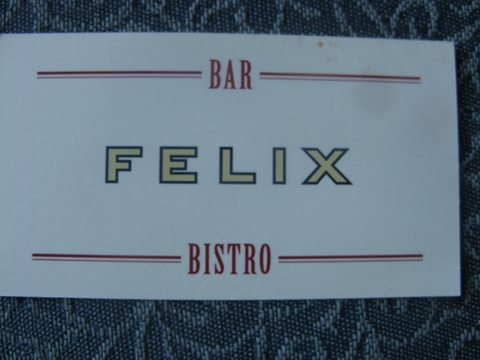
The hottest reservation in Sydney right now is Felix. Part of the Ivy complex, centrally located in George St only a few steps from Martin Place, it’s classic brasserie, offering traditional brassiere food, even if a few dishes have a slight nod to current Australian cuisine. It’s fitting that of all the nine eating options and nineteen bars that Merivale.com has unleashed on the city on this one site, that Felix draws the keenest crowd. It seems to be the latest step on the evolution of the brasserie, and there’s no equal in New Zealand.
Brasseries dominated the Parisien dining scene for decades. Grand in conception, accessible for most diners and boulevardiers, these classic establishments offered simple yet wonderful French food with a goodly selection of beers on tap, wines and plenty of Champagne. When I was a language student in Paris in the seventies, the brasserie La Coupole in Montparnasse was the place to go. There’s an iconic interview with Micky Jagger that was filmed there, and countless writers have included tales of long lunches, liaisons and dinners. Like all the grand brasseries of Paris, such as Terminus Nord, Flore, Lipp et al, art nouveau or belle epoque décor reigns, and banquette seating and freshly shucked oysters are de rigueur.
Many of Paris’ brasseries are now owned by the Group Flo, and have perhaps lost a little of their individuality, tending to process customers like they are all tourists. There’s a wonderful story in Adam Gopnik’s Paris to the Moon of how the regulars and neighbourhood tried to thwart the sale of their favourite haunt to this group. They lost. But my favourite Brasserie Bofinger, despite being owned by the Flo group, is still an essential call for me whenever I return to Paris. We even chose it last year to surprise a friend for a very significant birthday celebration.
The master of ‘restaurantism’ in New York, Keith McNally successfully recreated the Parisien model with his Balthazar brasserie in Soho. You’d swear you were in an old French institution with brass railed sections, plenty of banquettes, and a seedy paint job deliberately created to look like the place has been there forever. Superb classic dishes like steak and fries, pan fried whole sole, fishy soups and of course trays of freshly shucked oysters on the menu, and not forgetting wonderful sourdough bread and ice cold butter. No self respecting brasserie would ever serve olive oil! Balthazar is as hot as the day it opened, and you’re likely to sit next to a film star or a Ponzi trader.
So Felix had heaps of inspiration to draw on and have done the brasserie thing really successfully, albeit with a shiny new look rather than the distressed décor of Paris and New York. The bar especially is a gem, with plenty of room to imbibe while waiting for a table, even when you score the necessary reservation.
And the food at Felix? Deliciously authentic. There’s great hunks of chewy bread, ice cold butter (yay!) and a menu that’s not too long and not too complex. Five varieties of Sydney Rock oysters shucked to start, then a delicious smoked trout salad with sweet caperberries and lots of really fresh tiny greens, which reminded me of the perfect French bean salad with fresh lobster I had eaten at Bofinger last year; crisp, simple and very refreshing. There’s wonderful Reuben sandwich in a nod to New York, and tripe cooked Lyonnaise style or flank steak with a mountain of crisp golden chips in deference to France. French wines by the glass (the Sancerre was perfect with my oysters) good puds too and excellent coffee. I will be back, even if the Ivy folks think Felix is a bistro, rather then the brasserie it is.
330 George St, Sydney ph 61 2 9240 3000
18 February 2011
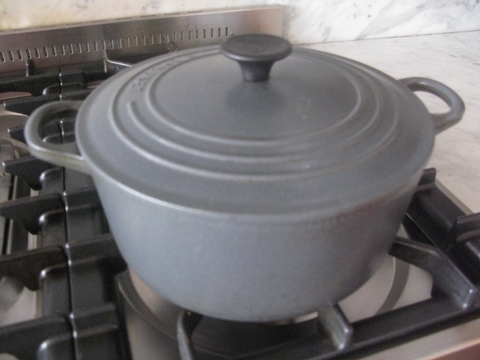
My neighbour had her two tiny grand daughters staying and their early rising, constant demand for attention and feeding, and frequent trips down to the beach were making her somewhat frazzled. So I made dinner for her. Next morning she asked me for the recipe for the gently braised chicken thighs I had prepared and delivered to her, along with crispy roast potatoes and beans and peas with mint.
Too many times I cook something that’s really scrumptious, but, as I am prone to spontaneous cooking that’s inspired by great produce rather than recipe books, I often can't recall exactly what I have done. (My son learned years ago to beg me to “write it down now Mum so we can have it again.”) And so I told Rosemary how I had browned the flour-dusted chicken pieces in oil in Le Creuset casserole and then removed them from the pan, added chopped fennel and aubergines to the residue with a little cumin, browned that and then returned the chicken along with fresh herbs, some chicken stock, salt and pepper and chopped preserved lemon. Once it came to a simmer I added the lid to the dish and transferred it to the oven. Her question was, “How long do you cook it for?”
My reply was to “cook it until it is delicious.” Now, I know that’s not really helpful, but it is very true. Oven temperatures vary, the sort of pan you cook in affects the result, and it also depends on how long you browned the meat/poultry etc in the first place and how big the pieces were, if they were on the bone or not, and other minor influencing factors.
When food writers record recipes, they write down exactly what they experienced. (At least we hope they all test their recipes at least once or twice before they print them.) What they cannot do is predict the exact temperature of your oven, what pan you will use and even what size you cut your food up. I once had the wonderful wine writer Ralph Kyte-Powell for dinner and cooked him a duck dish that had appeared in a magazine. He loved it and asked where I got the recipe. When I told him he was astonished. He had cooked the same recipe a week earlier and said mine was far more delicious than his. We discussed what we’d done. Ralph had stuck to the recipe and prescribed cooking times, while I had cooked the duck for a whole hour longer until it was truly tender and really falling off the bone. In other words, I had cooked it until it was delicious.
I heard on the grapevine the other day that the food writers in a life-style magazine have been briefed to provide recipes that only put simple ingredients together with minimal cooking. In other words, ASSEMBLING rather than COOKING food. Some may like that sort of recipe but there will be no room on those pages for a simple instruction like ‘cook until delicious’. Such a shame!
6 February 2011
On the 1 June 2010 I stuck my neck out on this blog and revealed my shopping habits. I went as far as to say I shopped at the Foodstuffs stores (Four Square, New world and Pak n’ Save’) and it was unlikely I would ever darken the door of their opposition supermarket chain, Progressive (Woolworths, Foodtown who have now almost all morphed into Countdown stores.) The reasons are there on my blog, http://www.laurainejacobs.co.nz/blog/?mode=post&post_id=101, and since then I have had many discussions with many people who have come to agree with my sentiments.
I also have spoken publicly, whenever given the chance, about how to shop so that a fresh and chemical-free diet is assured. So it was with a bit of that “I told you so” feeling that I read the lead story in today’s Sunday Star Times. The headline was ‘Gassing fakes meat freshness’. It was all about how Progressive Enterprises have acknowledged that some of the meat packs they sell are pumped with carbon dioxide and oxygen to extend their (refrigerated) shelf life. An Australian consumer magazine has found this and other refrigeration technology makes it possible for meat to be stored for months, and potential health hazards are posed because ‘harmful bacteria could grow to dangerous levels, while the food remains attractive to the eye.’ Perhaps a necessity when meat is increasingly processed in centralised facilities, as no doubt it is as part of Progressive’s centralised distribution system.
Foodstuffs, however, according to the SST article, do not gas flush ANY meat products. Good on them, and they will continue to get my dollars. (Dollars which stay in New Zealand!)
It’s all very scary. My mantra is ‘shop-from-the-displays-of-fresh-food-around-the-periphery-of-the-supermarket-and-only-venture-into-the-aisles once-a-month.’ That way you get to take home fresh food; meat, vegetables, fruit, fish, deli items, dairy products, and bread. These products are on the outside as that area is more accessible and often needs special daily or even hourly supervision and handling. All the stuff in the aisles is there because it is shelf-stable and doesn’t require the same sort of servicing. I can do a foray into the aisles about once a month and pick up all the necessities of life that lurk there; washing and hygiene products, the basics for baking and cooking, and cans or jars of food for total emergencies. The shelf items that are edible almost all have stabilisers and preservatives and additives chemicals that can harm my body. Fresh foods just don’t have this potentially evil stuff.
But if our supermarkets start tampering with what we perceive to be fresh food, we’re going to be in trouble. We must all wake up to what it exactly is that we’re putting in our bodies and vote with our shopping habits. I know where I will continue to shop. Somewhere I can see a real butcher.
21 January 2011
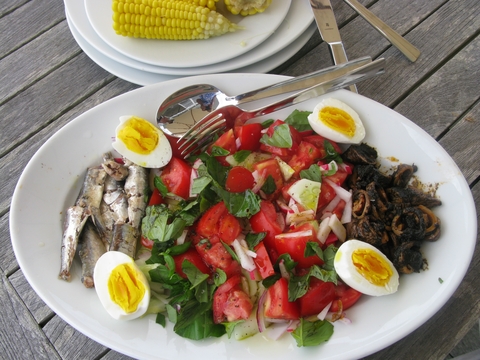
One of the things I love about summer is the ease with which I can throw a simple platter of great food together, with a little help from the store cupboard. I always have fresh tomatoes (they are outdoor grown and full of flavour right now - shame on anybody not seeking them out at their local farmers market), red onions (ditto), apple cucumbers (ditto) and of course basil that's everywhere; in the garden, in pots on the deck and on my kitchen bench. And from my pantry, canned Spanish sardines (Albo brand from Sabato) and Spanish octopus in its own ink (ditto).
And so I can whip up the platter pictured above in the time it takes to boil the orchard fed free range eggs. It's as simple as put the eggs on, chop the tomato, onion and cucumber and pile it into the middle of the plate and drizzle it with some lovely EVOO and torn up basil leaves. Open the cans of sardines and calamares and place them at each end. The eggs are ready now, so peel them under cold running water, cut in half and wedge them onto the plate too.
And to go with this easy lunch, some fresh corn as I am not eating bread presently. And for drinking, I like an ice cold beer. Right now it will be a choice of Leffe Blonde (if I am not watching my pennies) or Steinlager Pure which I recently discovered. Not sure just why this discovery took so long, but I am a fan.
How easy and how delicious is that?
13 January 2011
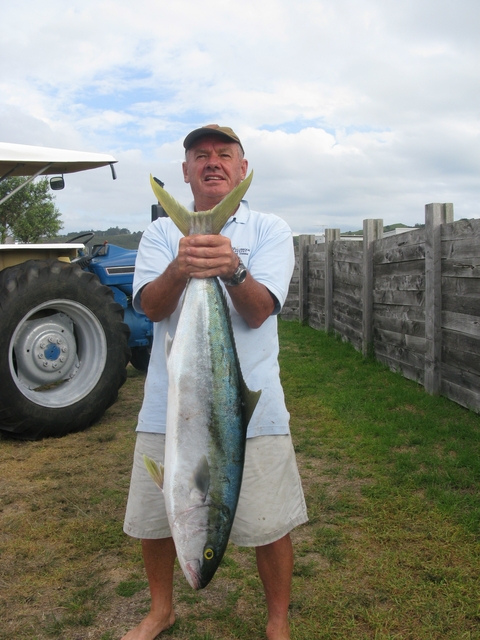
In the picture above you can see Muzza with his pride and joy of the week; a 17.5kg kingfish caught from his boat Raindear. (The name is a play on my nickname, 'Laurainedeer' and that's quite some joke as I have never been out on the ocean with him!)
So we have enjoyed kingfish fillets panfried in oil and a little butter with lemon juice, kingfish sashimi and a wonderfully fragrant kingfish curry (the recipe is on the recipe page of this website). Fabulous eating and for once Muzza probably justified the money he spends on petrol for that boat. Fresh fish is fabulous to eat when you're over looking the ocean, and we have had superb snapper regularly this summer, along with locally gathered tuatuas and the local Mahurangi oysters.
This is the time of the year when the locavore in me really comes out. I don't need to go further afield for food, as I can feast on an abundance of fresh fruit and vegetables from the local farms sold daily at their gates, and from the Matakana farmers market each Saturday.
We are loving the spuds (Rua, Red Rascal and Agria) which hardly need more than a quick wash under running water before cooking as their skins are so delicate. The outdoor tomatoes are simply delicious; full of flavour and rich red juices. There are about five varieties of beans to be found, which I simply steam and dress with avocado oil.
And then there's fennel, radishes, cucumbers, sweet corn, red onions, watermelon, plums, blueberries, late harvest mandarins, and courgettes till they come out my ears. Now this week the aubergines are ripening and I grilled some on the barbecue and they were sweet, creamy and smoky all at once! (Recipe on the recipe page).
I have herbs growing in pots on my deck, more herbs in the garden and I am in summer heaven.
1 January 2011
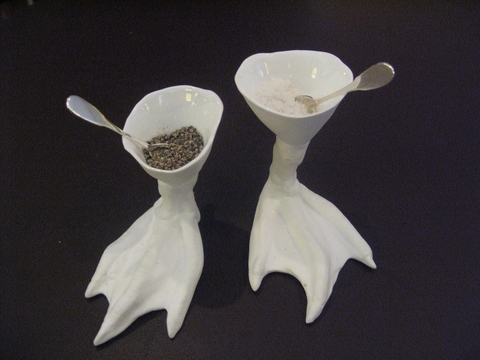
It’s the last day of the year. A chance to think about the good stuff and the best meals I enjoyed outside New Zealand. Here are the highlights in no particular order. Pic is the condiments at Helen Darroze in Paris.
The Food Carts of Portland, Oregon. What a responsible and sympathetic city council that licences immigrants and young cooks to cook the delicious treats of their homelands and imaginations and serve them from carts placed in parking lots and unused building sites around the city. The best I tried? Ziba’s Pitas; unlike anything that is ever served as ‘pita’ here in NZ. Tasty spiced meat or vegetarian with fresh cheese in a soft flaky warmed bread pocket.
Two San Francisco restaurants not to miss. Flour and Water, and La Mar. Flour and Water, despite the long queues, is worth the effort to get there. Fabulous fresh seasonal food served with a casual style that is delightfully refreshing in a world of tortured food. Everything we ate, we had spotted at the farmers market at the Ferry Plaza that very day. And La Mar, on the SF waterfront introduced me to Peruvian cuisine; causas, empanadas, ceviches and to top it all, Pisco Sours. Brassy, bright and happy.
Quay’s breathtaking views almost out-muscles the breathtaking food at this amazing restaurant on Sydney’s Circular Quay. Eat your heart out Melbourne! Peter Gilmore made it into the World’s Top 50 and so deserves it for his imaginative, stylish food that is oh-so-beautifully presented. The dessert with wild raspberries, sorbet and cream- in- the-jelly sphere was the best I ate all year.
Berowra Waters Inn, with Dietmar Sawyere at the helm we found the most perfect place in the world to go for lunch. Fly in a seaplane from Rose Bay or drive the ridiculously crowded highway to the upper reaches of Sydney’s Pittwater to this hideaway. Fabulous service, fabulous setting, fabulous food. The oyster beignets with vichyssoise have to be the best entrée I was served at a restaurant in 2010.
CSA & OOOBY. Community Supported Agriculture. I really admire the concept and delivery I saw in San Francisco and Portland of the weekly food box filled with fresh produce grown by a local farmer. Participants pay up in advance and the farmer can grow his crops, safe in the knowledge they will be enjoyed and consumed by an appreciative audience. (Also loved the OOOOBY initiative in New Zealand!)
The fishy restaurant tour I took of England’s South West. Lunch at Rick Stein’s Seafood Restaurant, even better (yes) fish and chips at the Porthminster Café in St Ives, Mark Hix’ Oyster and Fish Shack at Lyme Regis, and Michael Caines’ careful cooking at the Abode Hotel in Exeter with freshly smoked haddock and a poached egg for breakfast following on from amazing red mullet for the previous night’s dinner. Seafood is alive and kicking in Cornwall, Devon, Dorset and Somerset.
Back in London, highlights were the luxurious and centrally sited Langham Hotel (don’t miss the elegant cocktail lounge or the High Tea), JJ Sheekeys comforting fish pie, anything at Ottolenghi in Upper St Islington, and as ever the dazzingly fresh fish, Japanese style cooked by kiwi boy, Nic Watt’s, team at Roka. Still the best restaurant on the world.
Britain’s adherence to freshly produced sustainable food extends right down the food chain to fast food outlets like Leon, Prêt A Manger and Eat. Truly admirable and a huge lesson for New Zealand where we seem to just coast along on our supposed green and clean image.
Ballymaloe House, and Ballymaloe Cookery School in Shanagarry, Ireland. The wonderfully warm family led hospitality, the magnificent gardens and farm for the school, the Sunday night buffet presided over by Myrtle Allen and the sheer energy of Darina Allen are unforgettable.
Helene Darroze, Paris. A female chef with a comfortable two starred restaurant serving delicious south-western cooking. The trolley, complete with state of the art slicing machine delivered the most mouthwatering dried ham from the southwest to our tale as a gift to start a feast that was truly memorable.
Brasserie Bofinger near the Bastille in Paris for a surprise birthday for a dear friend. It may not be cutting edge food, but the service and atmosphere of those old belle époque brasseries of Paris is not to be missed. And my lobster with a large pile of crunchy French beans was a real treat.
Food in Hong Kong. China’s National Day with fireworks and a feast to remember at Hutong on the 47th floor overlooking the Harbour. A degustation dinner at the ritzy flagship restaurant in The Langham in Kowloon. The bustle of the gigantic shopping centre and endless food halls at Langham Place in Mongkok. And the noodle bar in the Cathay business class lounge is a pretty smart idea for weary travellers.
28 December 2010
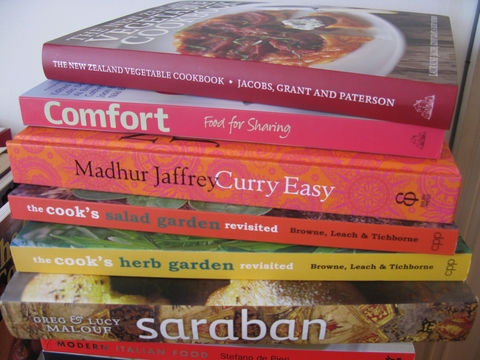
In recent weeks we’ve seen that to make a cook book a best seller, the author probably needs to be on TV and plaster the cover of the book with their very recognisable face. Jamie, Rick, Nigella and now our own Annabel have done exactly that with stunning results. But that’s left a large number of very good books sitting on the shelves when they should be in our kitchens, propped on the bench as we cook from them. So here’s a few of my recent acquisitions that I am loving cooking from.
- Saraban by Greg and Lucy Malouf (Hardie Grant)
I have been a long term fan of Greg Malouf’s spicy Middle Eastern cuisine since he did a guest chef star stint at Soul Bar. I already have a reservation to eat at his Melbourne Momo restaurant when I am over there in March for Masterclass. So this gorgeous book which is the tale, with recipes of Malouf’s journey through ancient Persia and modern Iran has already become a favourite of mine. I love the use of saffron, of rice, the fragrant herbs and the array of vegetables that bring inspiration to my table. And above all I get to take a peek through this wonderful chef’s eyes, at a land I will probably never get to visit. The photography is stunning.
- Curry Easy by Madhur Jaffrey (Random House)
If there’s a more elegant cook than the fascinating and stylish Madhur Jaffrey on this planet I would be amazed. Born in India and first and foremost known for her acting ability, Madhur has documented the cuisines of India in her books and BBC television shows. (And she’s coming to Auckland for the Writer’s festival in May.) Her newest book Curry Easy is a superb collection of recipes made easily, yet without the slightest ‘dumbing down.’ What she has done is make the curries more approachable with a smaller array of spices, so this is a book to motivate any cook to produce curries from the entire Indian subcontinent with ease and style.
- ‘The Cook’s Herb Garden’ and ‘The Cook’s Salad Garden’ – both revisited and extensively rewritten by sisters Mary Browne, Helen Leach and Nancy Tichborne (Craig Potton)
Three talented South Island sisters have spent hours working on revamping their lovely garden books. With useful notes and stories on how to grow, harvest and cook all the plants (and more) that are possible to nurture in a New Zealand garden, this pair of well produced books are a must in a country where almost 60% of the population is now making some effort to grow their own veggies and herbs. A delight to have in my kitchen.
- The New Zealand Vegetable Cookbook by Lauraine Jacobs, Ginny Grant & Kathy Paterson (Random House)
No apologies for recommending my own books! Kathy, Ginny and I worked hard to put this book together and had a lot of fun along the way. It seems there haven’t been many definitive veggie cook books since the days of Digby Law in the 70’s and early 80’s when cream and butter ruled, and olive oil was bought at the chemist, so this is a new take on our diet, We have put together some stunningly simple ideas to jazz up the veggies on our plates. And it's all arranged seasonally so there’s no excuse for not eating the food that is in abundance when it is fresh from the soil.
- Comfort; Food for Sharing. Recipes from the New Zealand Guild of Food Writers (Random House)
In November this fabulously useful book almost slipped under the radar when it was published. The generous food writers of NZ shared their favourite recipes, all written with friends in mind, who might need a little tender loving care. It’s all food that is easily transported and can be prepared a head for a friend or family in need. But it doesn’t stop there, as these are such good recipes they will quickly become favourites for your own family. And the entire royalties are being donated to the Starship Children’s Hospital Foundation. That’s reason enough to buy this excellent book.
19 December 2010

I have just spent three days hosting Darina Allen, one of the world’s true good food gurus. Darina probably needs no introduction as she’s on TV on the food channel, in our bookshops with a long list of super books, is a hard working ambassador and champion of Irish food, a dedicated leader of Slow Food and Terra Madre, and principal of the Ballymaloe Cookery School which she runs with her husband Tim in Shanagarry, County Cork. She’s also a concerned and loving mother to four adult children who are all married and all live within 15 minutes of her home, and who have so far provided Tim and Darina with seven grandchildren (the next is on the way.)
We had visited the Allens at Ballymaloe in September this year, and so had a privileged insight into their life’s work which is truly commendable (see my previous blog about our experience there, posted on 19 October.) But it was an equally good experience to move about Auckland and see the city’s food scene through Darina’s eyes. ‘Passionate’ is an overworked word, but this Irish cook is utterly passionate about organically raised food, about artisan farmers’ products, farmers markets and traditional cookery.
Her most recent book is “Forgotten Skills of Cooking; the Time-Honoured Ways are Best – over 700 Recipes Show You Why” and that title tells it all. Everything is in there that a cook should know, from traditional rice pudding, roasts and cured meats to recipes with modern twists such as crispy chicken livers with lime that I am going to have for supper tonight. But it’s the amazing extent of very helpful notes and explanations that make this book stand out above everything else I have read recently.
Darina spoke about her book, her passions and her life at Ponsonby cookbook store, Cook the Books on Thursday night and it was sad for the 30 or so people who were on the waiting list who missed out. About 60 fans (one had even driven from Whanganui) and cooks crammed into the store, sipped on Vidals wine and enjoyed treats prepared from Darina’s recipes by store owner Felicity O’Driscoll. Everyone fell in love with Darina and her passion for good food, and the store sold out of her Forgotten Skills book and several others.
I took Darina to our local New World supermarket and was impressed how quickly she managed to drill into the shelves, spotting and commenting on the many artisan products there. (Thank goodness New World Remuera ’s owner, Adrian Barkla stocks such a diverse range.) By the time we got to the check out, a simple trip to buy milk, lamb and sausages had turned into a major shopping expedition and we had local cheeses, three sorts of local organic yogurt, plenty of fruit including fresh seasonal apricots, butter and more. But all were products I was proud to see she’d spotted as good local high quality food.
We also visited two markets; the Parnell Trust farmers’ market in Parnell Rd, and the La Cigale French market. It’s slow going with Darina, as she stops and talks to all the farmers, tastes their products and makes notes everywhere. She loved everything, especially the Cathedral Cove macadamias and was delighted to meet Sue Pilkington, the leader of the local Slow Food convivium who with her son Hamish sells these Coromandel grown nuts at La Cigale. Once again we returned with bulging bags of produce Darina could not resist, despite the Allens leaving after our lunch later that day for their holiday trip around New Zealand.
We ate several meals at home, and Darina willingly helped with the preparation. She stewed apricots, adding masses and masses of sugar until they became almost jammy. She and Tim both loved the moist chewy Bavarian style rye bread we buy from Diehls bakery on Auckland’s North Shore, lovingly slathering every slice thickly with New Zealand butter. We enjoyed tiny spring lamb chops cooked on the barbecue one evening with friends (I was going to buy racks of lamb, but Darina insisted we choose the mid-loin chops with their even coating of fat – she was right, they were delicious.) And she found cream in the fridge and was quite amazed when I handed her my trusty old Swift Whip rotary beater to make whipped cream to pile onto dessert, in an eighth of the time it would have taken with the whisk she had reached for.
And as she set the table for our meals, she insisted on sea salt to sprinkle on everything. (She’d brought Maldon salt in her luggage but loved the New Zealand flaky salt from Marlborough.) The next two weeks will see Darina and Tim travelling around Central Otago (and hopefully visiting Milford weather permitting), Mt Cook, Christchurch, Hawkes Bay for the Farmers' market on Boxing Day and then travelling in a campervan through Northland which will include a return to Matakana Farmers’ Market which Darina was so impressed with on a visit four years ago that she vowed to return to again.
My husband, Murray was more than impressed with her energy and passion and told me last night he knows the secret of Darina’s success in the culinary world. “What’s that?” I asked. “Salt, sugar and butter,” he replied. He’s right about that of course, and it occurred to me that those ingredients are part of the forgotten skills of cookery in this modern age where fast and furious has tended to dominate the slow, the tasty and the seasonal food that should be at the heart of the food we all prepare. Enjoy New Zealand Darina, as we enjoy your fabulous passion!
Pic; Darina Allen at the Cook the Books store.
16 December 2010
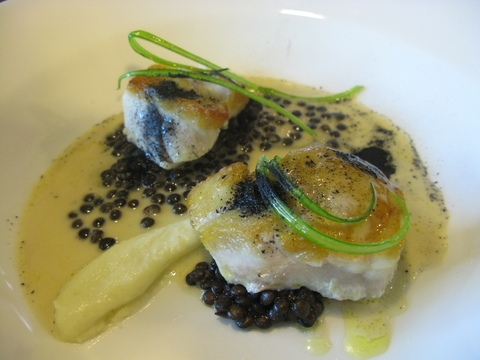
Delicious hapuku as cooked by Vaughan Mabee. See story below.
16 December 2010
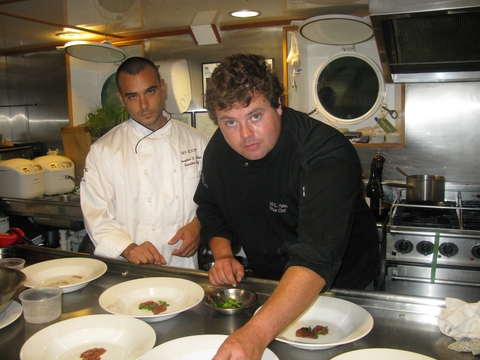
Vaughan Mabee started his culinary journey in the kitchens of Cin Cin on Quay, in the historic Auckland Ferry Building. From that start (a place where many young Kiwi chefs have begun) he has risen to the top, just like cream, to cook most recently at the restaurant currently rated Number One in the world’s list of Top Restaurants, Noma, in Copenhagen.
Vaughan's early CV lists his head chef position at the ridiculously young age of 21 at the now disappeared Praxis in Auckland where he experimented with unique New Zealand ingredients mixed up with classic European cuisine. That didn't last long, so he found a position at Killarney St on Auckland's North Shore before heading off to the USA.
Near San Diego, the ritzy La Valencia Hotel stands in a prime position overlooking the La Jolla coastline. In this lovely Californian Mission-style hotel Vaughan became Executive Chef of the flagship restaurant, The Sky Room. This is where he admits he finally found his true passion for modern cooking and produced meals that wowed the locals from far and wide.
His next career step, to Europe, truly took him near the top, for he won a position heading up the "workshop" for Martin Berasategui's eponymous and cutting edge restaurant in San Sebastien in northern Spain. Vaughan was now in the thick of the experimental and avant garde cooking that has seen Spain lead the charge of modern food. He worked on developing menu ideas and recipes for Berasategui, who consistently scores top ratings in Michelin, the World’s Top 50, and everything that matters in the restaurant world.
From there it was short European hop to Noma. Rene Redzepi has had much written about him and has been instrumental in taking a new turn with his very modern food. He's moved from the experimental, almost- scientific style of food, to ensuring his diners experience the true tastes of fresh pristine produce. What appears simple may be quite complex but is always very delicious. A perfect place for a Kiwi with Vaughan's experience and enthusiasm to work. Lucky man!
Few New Zealanders will be lucky enough to ever taste this style of cuisine, so I was really privileged to be invited to lunch on the Island Passage, a small luxury catamaran cruiser. Vaughan is currently working the southern summer in the ship’s galley, pampering up to twenty guests on cruises in the South Pacific and around the New Zealand Coast this season. He cooked a four course light luncheon for five of us that was superbly styled, utterly delicious and a showcase of everything he loves about his home country.
To start, tiny pieces of pristinely fresh kingfish were served, topped with “scales” which proved to be the most delicately sliced grapes, and garnished with baby watercress, a wafer made from sago that had been cooked, then deep fried and was a playful take on Chinese-style prawn crackers. To finish the dish Vaughan had made a jus of mussel juices which had amazing depth of flavour.
My favourite course was the main, two nuggets of butter poached flaky fresh hapuku nestling into a bed of caviar lentils and cauliflower puree, topped with charcoal dust and bathed in the most divine seafood bisque style sauce that had everyone literally licking their plates. (See the pic above.)For dessert Vaughan had delved into his childhood memories of New Zealand fruit and created a trio of ices; frozen tamarillo granita, feijoa sorbet and olive oil ice cream. This was all food that was light, intriguing and left me wanting another spoonful or two each course. Fabulous!
As I walked off the little ship, I pondered just why so many of our chefs go overseas, (well that’s obvious when they can get experience like Vaughan has had) but then so few return. I can think of many top rated New Zealand born and trained chefs who now reside and cook at the top of their game in Sydney, London, Melbourne, New York, Bali and many more places. Our loss is the world’s gain.
Pic: Vaughan Mabee in the galley of the Island Passage.
